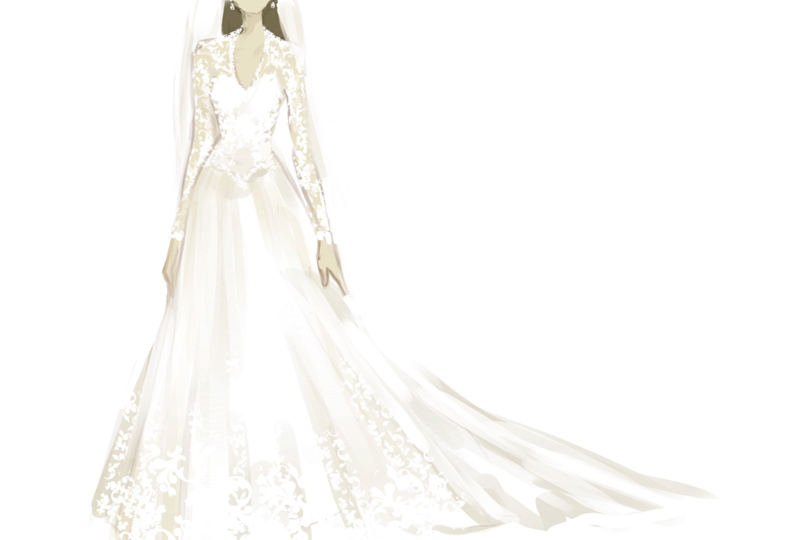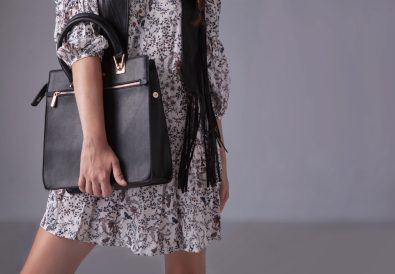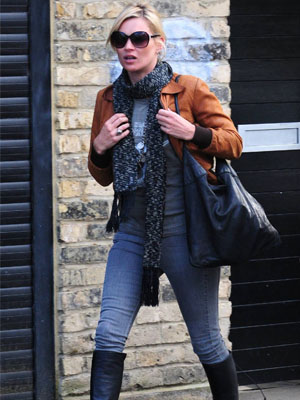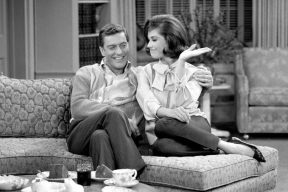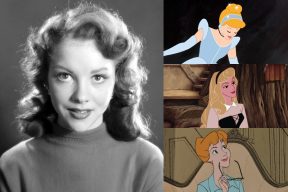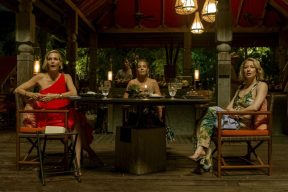Part of an ongoing series of 29Secrets stories, taking a deep dive into the history of legendary beauty products and iconic fashion and pop culture moments…
By Christopher Turner
Illustration by Michael Hak
On April 29, 2011, Catherine “Kate” Middleton married Prince William at Westminster Abbey in London, UK, with tens of millions of people watching around the world. The buildup to the royal wedding had attracted intense media attention in the months and weeks leading up to the big day, so much attention that some royal watchers compared the spectacle to the 1981 marriage of William’s parents, Lady Diana Spencer and Charles, Prince of Wales. Thirty years later, history seemed to be repeating itself with an incredible amount of speculation over what Kate would wear – but, like Diana, the bride (and Buckingham Palace) kept people guessing by not formally announcing any details about the royal wedding dress or its maker until Kate stepped out of her car to enter Westminster Abbey just moments before the service.
Kate’s wedding dress was created by London-based designer Sarah Burton, the creative director of the luxury fashion house Alexander McQueen. Burton – the late Lee Alexander McQueen’s right hand, a formidable successor to her mentor’s label and genius – designed a wedding dress that received instant universal acclaim. It featured a high lace collar, a lace bodice that was padded on the hips, long sleeves, sweeping ivory satin skirts and a dramatic nearly nine-foot train that gracefully swept behind as she walked. The Alexander McQueen label was an unexpected choice for a royal wedding, but according to the palace, Kate opted for the label because of “the beauty of its craftsmanship,” adding that she wanted her dress to “combine tradition and modernity with the artistic vision that characterizes Alexander McQueen’s work.”
Kate’s dress remains one of the most loved royal wedding dresses of all time, and is still a reference point for countless brides-to-be looking to emulate her iconic look. Here’s the full story behind Kate Middleton’s impeccable wedding gown designed by Sarah Burton for Alexander McQueen.
Kate and William
The couple first met in 2001 while studying at the University of St Andrews in Scotland, but didn’t actually begin their romantic relationship until 2003.
“When I first met Kate, I knew there was something very special about her,” William recalled years later.
After years of dating, the couple was engaged on October 20, 2010, on a private holiday in Kenya; William gave Kate the same engagement ring that his father had given to his mother, a stunning white gold ring with a 12-carat oval sapphire and 14 round diamonds. Their engagement was formally announced on November 16, 2010. And although the ring may be the same, William was adamant that there was no pressure on Kate to be the “next Diana.”
“No one is trying to fill my mother’s shoes,” William said. “It’s about carving your own future and your own destiny, and Kate will do a very good job at that.”
Speculation over designer
Before the wedding, there was intense media speculation over who would be designing Kate’s dress. After all, when William’s parents were engaged, Diana’s over-the-top wedding dress (created by husband-and-wife team David and Elizabeth Emanuel) was declared the “most closely guarded secret in fashion history,” and was a complete mystery until its dramatic unveiling on the morning of July 29, 1981.
Security wasn’t as steel-tight for William and Kate’s wedding, it seems. On March 6, just over a month before the wedding, The Sunday Times reported on speculation that Kate had chosen McQueen designer Sarah Burton. Their report stated: “A fashion source said that the dress will be a combination of Middleton’s own design ideas and Burton’s deep knowledge and understanding of high fashion.” Of course, both the label and Burton denied any involvement.
Other designers rumoured to be designing the royal wedding dress included Elizabeth Emanuel, Victoria Beckham, Marchesa by Keren Craig and Georgina Chapman, and Stella McCartney, among others – but Sarah Burton emerged as the odds-on favourite among bookmakers, especially after media hounds recalled that Kate had previously attended the wedding of Tom Parker Bowles, the son of the Duchess of Cornwall, and McQueen had designed the wedding dress for Bowles’ bride, fashion journalist Sara Buys.
McQueen seemed an unusual choice for a royal wedding. Founded by designer Lee Alexander McQueen in 1992, the house’s early collections developed its reputation for controversy and shock tactics (earning the designer the title “l’enfant terrible” and “the hooligan of English fashion”), with trousers aptly named “bumsters” and a collection entitled Highland Rape. After McQueen’s suicide was announced on the afternoon of February 11, 2010, Sarah Burton, who had been McQueen’s deputy for 14 years, became the label’s creative director. Under her direction, the label underwent a subtle shift, ultimately focusing more on exquisite tailoring rather than the dramatics.
“With Lee, each show was so completely autobiographical,” said Burton. “The dresses could tell their own stories because the fashion was really an avatar of his personal journey.”
The big day
Speculation ended when Kate stepped out of a Rolls-Royce Phantom VI in front of Westminster Abbey at 11:00 am on April 29, 2011, wearing an elegant lace bridal gown that is believed to have cost her parents, Carole and Michael Middleton (who footed the bill), £250,000. That estimation makes it one of the most expensive dresses of all time.
Official statements from the palace noted that Kate worked quite closely with Burton on the delicate design of the dress, which was inspired by traditional arts and crafts while “giving the cut and the intricate embellishment a distinctive, contemporary and feminine character.”
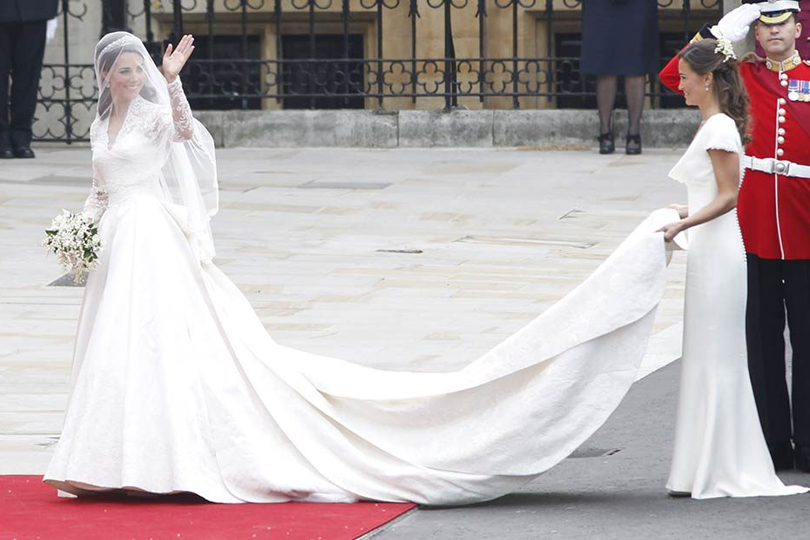
The dress was a work of art. It was custom made and featured a V-neckline with a high lace collar, long lace sleeves, a fitted Victorian bodice that narrowed at the waist and, in signature McQueen style, padding on the hips. On the back were 58 buttons of gazar and organza fastened by means of rouleau loops, and the train measured nearly nine feet long. The main body of the dress was made of ivory and white satin gazar, and the skirt mimicked an ‘opening flower’ thanks to white satin gazar arches and pleats. The design was appliquéd with individual symbolic flowers representing the four parts of the United Kingdom – the rose, thistle, daffodil and shamrock. Each flower was hand-cut from lace, and then hand-engineered onto ivory silk tulle. The bodice and skirt were made from hand-cut English lace and French Chantilly lace, while ivory and white satin gazar was used in the body of the dress and its skirts.
The lace was hand-made at London’s Royal School of Needlework (based at Hampton Court Palace), and every effort was made to ensure perfection: for example, seamstresses had to wash their hands every 30 minutes to make sure the lace remained pristine.
As for the accessories? Kate wore a simple full veil, made from layers of soft ivory silk tulle with a trim of hand-embroidered flowers. The veil was held in place by a sparkling Cartier halo tiara, lent to her by William’s grandmother, Queen Elizabeth. (It’s a tradition of royal weddings for the Queen to lend the bride a tiara. The Queen also gave the couple another present on the day of the wedding, by the way, naming them the Duke and Duchess of Cambridge.) The tiara had been commissioned in 1936 by King George VI (William’s great-grandfather), and was presented to the Queen on her 18th birthday, when she was still Princess Elizabeth. The bride also wore diamond earrings by Robinson Pelham, a gift from her parents. These consisted of diamond-set stylized oak leaves with a pear-shaped diamond set drop and a pavé set diamond acorn suspended in the centre, mimicking the Middleton family’s new coat of arms, which includes acorns and oak leaves.
Her shoes were hand-made by the team at Alexander McQueen, in ivory duchesse satin with hand-embroidered lace, to match the dress. Middleton’s bouquet, meanwhile, was made up of myrtle, lily of the valley, sweet William and hyacinth.
Ultimately, Kate followed bridal tradition with something old, new, borrowed and blue for the ceremony. Old was represented by a lace technique dating back to the 1800s on her wedding dress; new was represented by the earrings given to her by her parents; borrowed was represented by the halo tiara from the Queen; and blue was represented in the form of a blue ribbon that had been sewn into the dress.
Discussing the dress, Burton said in a statement, “It has been the experience of a lifetime to work with Catherine Middleton to create her wedding dress, and I have enjoyed every moment of it. It was such an incredible honour to be asked, and I am so proud of what we and the Alexander McQueen team have created. I am delighted that the dress represents the best of British craftsmanship. Alexander McQueen’s designs are all about bringing contrasts together to create startling and beautiful clothes, and I hope that by marrying traditional fabrics and lacework with a modern structure and design, we have created a beautiful dress for Catherine on her wedding day. The last few months have been very exciting and an incredible experience for my team and I, as we have worked closely with Catherine to create this dress under conditions of the strictest secrecy.”
And, in an attempt to explain why the label had repeatedly denied any involvement in the dress’s design in the weeks leading up to the wedding, Burton said: “Understandably, Catherine has been very keen to keep the details of her dress a secret, which is every bride’s prerogative, and we gave an undertaking to keep our role confidential until the day of the wedding.”
Burton continued: “Catherine looked absolutely stunning today.… The dress was just one component of a spectacular day, and I do not think it is appropriate to comment any further beyond saying that I personally am very grateful and honoured to have been given the opportunity to work on this project, and I wish TRH The Duke and Duchess of Cambridge every good wish for the future.”
Following the reception, William and Kate drove from Buckingham Palace to Clarence House (home of William’s father, Prince Charles) in a blue open-top vintage Aston Martin, strewn with balloons and bearing the number plate “JU5T WED” on the back, to cheers from the crowds.
“It was a joyful ceremony, and very simple really,” said Monica Main, one of Queen Elizabeth’s personal representatives in Scotland. “Catherine’s dress was very plain but wonderful.”
The evening wedding dress
For her wedding reception, Kate changed into a second stunning dress, also designed by Sarah Burton for Alexander McQueen. It was simpler and easier to move in, no doubt enabling the bride to hit the dance floor at Buckingham Palace.
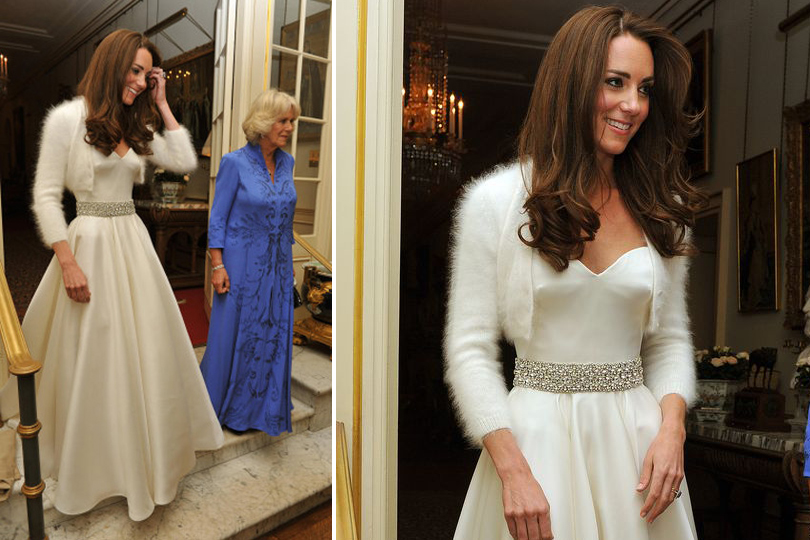
The dress was strapless and featured a sweetheart neckline, with a nipped-in waist and A-line skirt, all made of ivory satin as a nod to the first dress. It was embellished at the waist with a crystal belt, and the bride kept warm with a cropped wool cardigan.
This dress was actually the third look created by Burton for the royal wedding day. Burton and her team at Alexander McQueen designed not only the bride’s two ensembles but also the gown that Kate’s sister and maid of honour, Pippa Middleton, wore at the wedding. Pippa’s dress was made of an ivory, satin-based crepe and had the same buttons and lace trims as the bride’s gown.
The aftermath
Kate’s wedding dress quickly joined the ranks of the most famous royal wedding dresses in history, and as is tradition with many royal weddings, it was displayed at an exhibit just months after the wedding took place. The dress was featured in the Ballroom at Buckingham Palace during the palace’s annual summer opening, and was on display from July 22 through October 3, 2011.
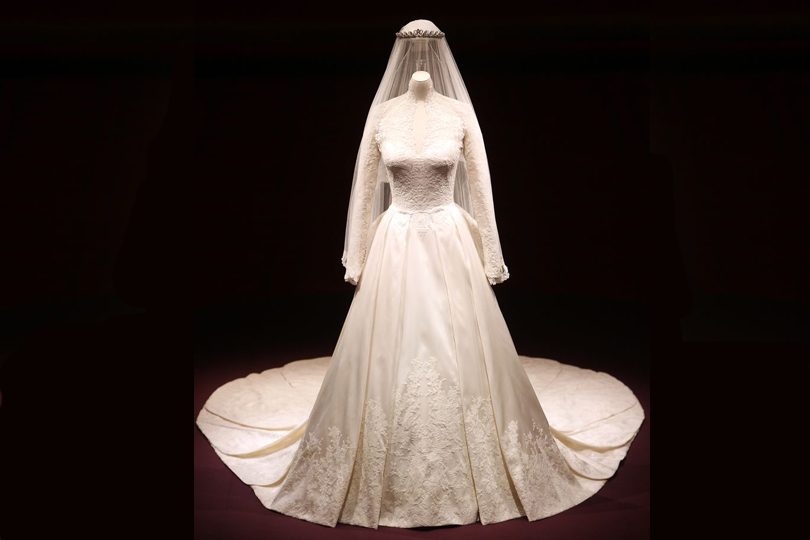
During the exhibition, 600,000 tickets were sold to see the dress. Also on display were the bride’s tiara and earrings, as well as her wedding shoes, a replica of her wedding bouquet and the extravagant wedding cake created by Leicestershire-based cake designer Fiona Cairns.
As for the whereabouts of the royal wedding dress today? Let’s assume it’s being kept in pristine condition in storage somewhere at Buckingham Palace or Kensington Palace (the official home of the Duke and Duchess) until the next exhibition.
![]()
Want more? You can read other stories from our The Story Of series – including The History Of Princess Diana’s Wedding Dress – right here.

